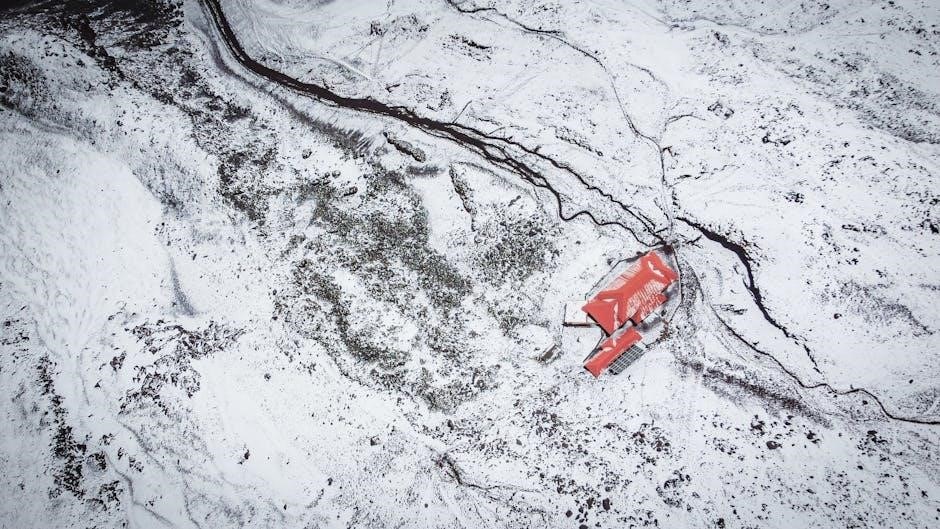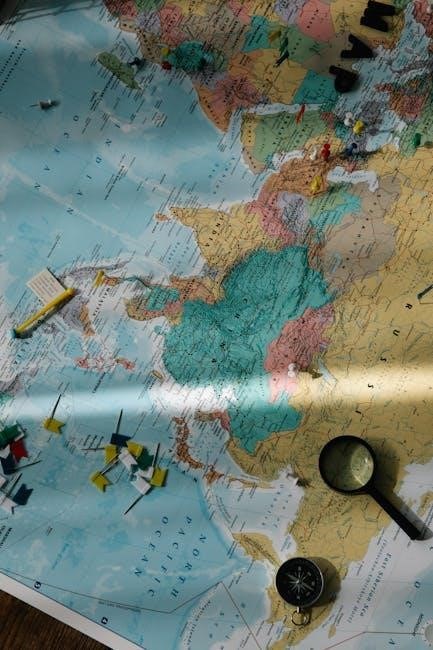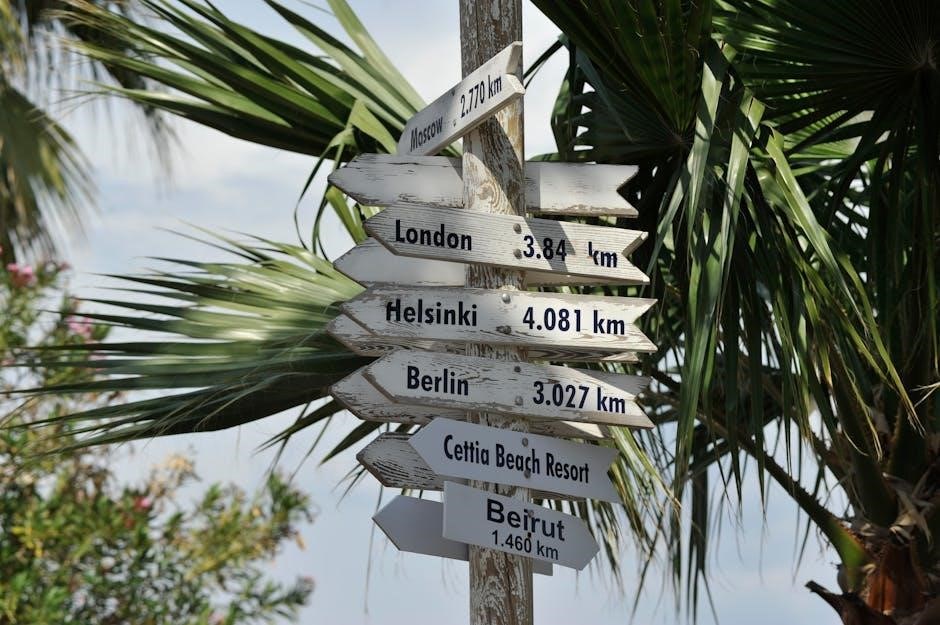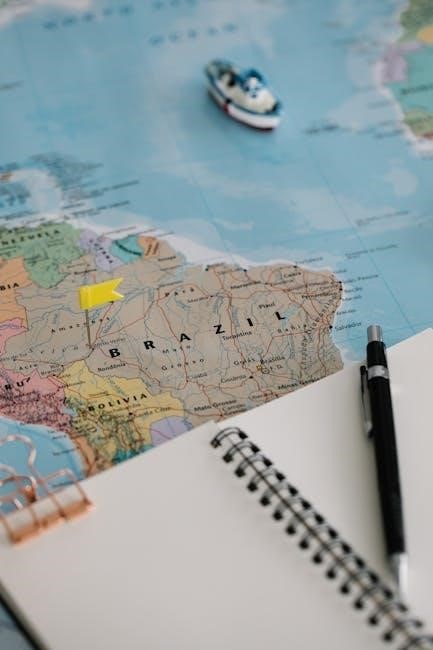Latitude and longitude are essential geographic coordinates that determine Earth’s surface positions. Worksheets on these topics help students understand map-reading skills and global positioning systems effectively.
1.1 Understanding Latitude and Longitude Basics
Latitude and longitude are fundamental geographic concepts used to identify locations on Earth. Latitude measures the north-south position, ranging from 0° at the equator to 90° at the poles. Longitude measures the east-west position, ranging from 0° at the Prime Meridian to 180° east or west. Together, they form a grid system that allows precise location identification. Worksheets often include exercises to plot coordinates, enhancing understanding of these essential mapping tools. They also introduce how to use these coordinates for navigation and geography studies.

1.2 Importance of Latitude and Longitude in Geography
Latitude and longitude are vital for precise location identification, enabling accurate mapping and navigation. They form the foundation of geographic coordinate systems, essential for cartography, aviation, and maritime industries. Understanding these concepts enhances spatial awareness and facilitates global communication. Worksheets on latitude and longitude help students grasp these principles through practical exercises, fostering a deeper appreciation of geography and its real-world applications. They also support skills in reading maps and interpreting data, which are critical for various professions and everyday navigation.

Benefits of Using Latitude and Longitude Worksheets
Latitude and longitude worksheets enhance map-reading skills, improve geographic knowledge, and support real-world navigation. They provide practical exercises for understanding Earth’s coordinate system effectively and accurately.
2.1 Enhancing Map-Reading Skills
Latitude and longitude worksheets are invaluable for improving map-reading abilities. By plotting coordinates and identifying locations, students develop spatial awareness and accuracy. These exercises teach how to distinguish hemispheres, oceans, and continents, fostering a deeper understanding of global geography. Interactive tasks, such as labeling maps and solving puzzles, make learning engaging. Mastery of these skills aids in navigating real-world scenarios, from GPS usage to environmental studies, making worksheets an essential tool for geographic literacy and practical application.

2.2 Improving Geographic Knowledge for Students
Latitude and longitude worksheets are designed to enhance students’ understanding of global geography. By engaging with these tools, learners gain proficiency in identifying hemispheres, understanding time zones, and locating countries. Interactive exercises, such as mapping coordinates and solving puzzles, foster critical thinking and spatial awareness. These resources also introduce students to real-world applications, like GPS navigation and environmental studies, making them invaluable for building a strong foundation in geographic knowledge and skills.

Components of a Typical Latitude and Longitude Worksheet

A typical worksheet includes multiple choice questions, fill-in-the-blank exercises, and map labeling activities. These components help students practice identifying coordinates, understanding hemispheres, and locating global positions accurately.
3.1 Multiple Choice Questions

Multiple choice questions in latitude and longitude worksheets test students’ understanding of key concepts. They often ask about identifying coordinates, determining hemispheres, or locating geographical features. These questions provide clear options, making it easier for students to assess their knowledge. Worksheets may include questions like, “Which ocean does the Prime Meridian cross?” or “What defines a northern latitude?” Such exercises enhance retention and comprehension of the subject matter effectively. They are a popular feature in many educational resources available online.
Multiple choice questions in latitude and longitude worksheets are designed to evaluate students’ grasp of fundamental concepts. They typically cover topics such as identifying coordinates, understanding hemispheres, and recognizing global positions. These questions present clear options, simplifying the assessment process for students. Examples include, “Which hemisphere is Miami located in?” or “What is the significance of 0° latitude?” These exercises are widely used in educational materials to reinforce learning and ensure a solid understanding of geographic principles.
Multiple choice questions in latitude and longitude worksheets are a key component of geography education. They test students’ ability to identify coordinates, recognize hemispheres, and locate geographical features. These questions offer straightforward options, making it easier for students to evaluate their knowledge. Common examples include, “What is the equator’s latitude?” or “Which ocean does the Prime Meridian intersect?” Such exercises are integral to many educational resources, helping students master essential geographic skills in an engaging manner.

Multiple choice questions in latitude and longitude worksheets are a valuable tool for assessing students’ understanding of geographic concepts. They cover topics like coordinate identification, hemisphere recognition, and global positioning. These questions provide clear options, aiding students in evaluating their knowledge. Examples include, “What is the latitude of the North Pole?” or “Which continent is at 0° longitude?” These exercises are featured in various educational materials, ensuring students gain a comprehensive grasp of latitude and longitude systems.
Multiple choice questions in latitude and longitude worksheets are an effective way to test students’ knowledge of geographic coordinates. They address topics such as identifying hemispheres, locating geographical features, and understanding the significance of specific latitudes and longitudes. These questions offer clear options, simplifying the evaluation process. Examples include, “What is the Southern Hemisphere’s defining latitude?” or “Which city is near 40°N latitude?” These exercises are commonly found in educational resources, aiding students in mastering essential geography skills.
Multiple choice questions in latitude and longitude worksheets are designed to assess students’ understanding of geographic principles. They focus on identifying coordinates, recognizing hemispheres, and locating global positions. These questions provide clear options, making it easier for students to evaluate their knowledge. Examples include, “What is the latitude of the Tropic of Cancer?” or “Which ocean is at 180° longitude?” Such exercises are integral to many educational materials, helping students develop a strong foundation in geography.
Multiple choice questions in latitude and longitude worksheets are a crucial part of geography education. They test students’ ability to identify coordinates, recognize hemispheres, and locate geographical features. These questions offer straightforward options, simplifying the assessment process. Examples include, “What is the longitude of Greenwich, England?” or “Which state is near 35°N latitude?” These exercises are widely used in educational resources, ensuring students achieve proficiency in understanding geographic coordinates.
Multiple choice questions in latitude and longitude worksheets are an essential tool for evaluating students’ knowledge of geographic concepts. They cover topics such as identifying hemispheres, locating global positions, and understanding the significance of specific coordinates. These questions provide clear options, aiding students in assessing their understanding. Examples include, “What is the latitude of the Arctic Circle?” or “Which country is at 90°E longitude?” These exercises are featured in various educational materials, helping students master essential geography skills.
Multiple choice questions in latitude and longitude worksheets are designed to test students’ understanding of key geographic principles. They address topics like identifying coordinates, recognizing hemispheres, and locating geographical features. These questions offer clear options, making it easier for students to evaluate their knowledge. Examples include, “What is the longitude of the International Date Line?” or “Which city is near 50°N latitude?” These exercises are integral to many educational resources, ensuring students gain a comprehensive understanding of latitude and longitude systems.
Multiple choice questions in latitude and longitude worksheets are a popular method for assessing students’ knowledge of geographic coordinates. They cover topics such as identifying hemispheres, locating global positions, and understanding the significance of specific latitudes and longitudes. These questions provide clear options, simplifying the evaluation process. Examples include, “What is the Southern Hemisphere’s defining latitude?” or “Which continent is at 0° longitude?” These exercises are commonly found in educational materials, aiding students in mastering essential geography skills.
Multiple choice questions in latitude and longitude worksheets are an effective way to evaluate students’ understanding of geographic concepts. They focus on identifying coordinates, recognizing hemispheres, and locating global positions. These questions offer straightforward options, simplifying the assessment process. Examples include, “What is the latitude of the equator?” or “Which ocean is at 90° longitude?” Such exercises are integral to many educational resources, helping students develop a strong foundation in geography.
Multiple choice questions in latitude and longitude worksheets are a valuable tool for assessing students’ knowledge of geographic principles. They address topics such as identifying hemispheres, locating geographical features, and understanding the significance of specific latitudes and longitudes. These questions provide clear options, aiding students in evaluating their knowledge. Examples include, “What is the latitude of the North Pole?” or “Which city is near 40°N latitude?” These exercises are featured in various educational materials, ensuring students gain a comprehensive grasp of latitude and longitude systems.
Multiple choice questions in latitude and longitude worksheets are designed to test students’ understanding of key geographic concepts. They cover topics such as identifying coordinates, recognizing hemispheres, and locating global positions. These questions offer clear options, making it easier for students to evaluate their knowledge. Examples include, “What is the longitude of Greenwich, England?” or “Which state is near 35°N latitude?” These exercises are widely used in educational resources, ensuring students achieve proficiency in understanding geographic coordinates.
Multiple choice questions in latitude and longitude worksheets are a crucial part of geography education. They test students’ ability to identify coordinates, recognize hemispheres, and locate geographical features. These questions offer straightforward options, simplifying the assessment process. Examples include, “What is the latitude of the Tropic of Cancer?” or “Which ocean is at 180° longitude?” Such exercises are integral to many educational materials, helping students develop a strong foundation in geography.
Multiple choice questions in latitude and longitude worksheets are an essential tool for evaluating students’ knowledge of geographic concepts. They cover topics such as identifying hemispheres, locating global positions, and understanding the significance of specific coordinates. These questions provide clear options, aiding students in assessing their understanding. Examples include, “What is the latitude of the Arctic Circle?” or “Which country is at 90°E longitude?” These exercises are featured in various educational materials, helping students master essential geography skills.
Multiple choice questions in latitude and longitude worksheets are designed to test students’ understanding of key geographic principles. They address topics like identifying coordinates, recognizing hemispheres, and locating geographical features. These questions offer clear options, making it easier for students to evaluate their knowledge. Examples include, “What is the longitude of the International Date Line?” or “Which city is near 50°N latitude?” These exercises are integral to many educational resources, ensuring students gain a comprehensive understanding of latitude and longitude systems.
Multiple choice questions in latitude and longitude worksheets are a popular method for assessing students’ knowledge of geographic coordinates. They cover topics such as identifying hemispheres, locating global positions, and understanding the significance of specific latitudes and longitudes. These questions provide clear options, simplifying the evaluation process. Examples include, “What is the Southern Hemisphere’s defining latitude?” or “Which continent is at 0° longitude?” These exercises are commonly found in educational materials, aiding students in mastering essential geography skills.
Multiple choice questions in latitude and longitude worksheets are an effective way to evaluate students’ understanding of geographic concepts. They focus on identifying coordinates, recognizing hemispheres, and locating global positions. These questions offer straightforward options, simplifying the assessment process. Examples include, “What is the latitude of the equator?” or “Which ocean is at 90
3.2 Fill-in-the-Blank Exercises
Fill-in-the-blank exercises in latitude and longitude worksheets are designed to test students’ ability to recall specific geographic details. These exercises often require students to fill in coordinates, geographic terms, or locations. For example, “The Prime Meridian is at ______ longitude,” or “Miami, Florida, is located near ______ latitude.” These activities help improve retention and understanding of key concepts. They are commonly included in educational resources to enhance students’ familiarity with geographic coordinates and their practical applications.

3.3 Map Labeling Activities
Map labeling activities in latitude and longitude worksheets involve identifying and marking key geographic features. Students are often asked to label lines of latitude and longitude, such as the Equator or Prime Meridian, and significant locations like oceans, countries, or cities. These exercises enhance spatial awareness and help students visualize how coordinates correspond to real-world places. For example, labeling the intersection of 0° latitude and 0° longitude or identifying hemispheres. Such tasks make learning interactive and reinforce the practical application of geographic coordinates.
How to Create Effective Latitude and Longitude Worksheets
Design engaging worksheets with clear instructions, varied exercises, and real-world examples. Incorporate interactive tools like GPS coordinates and digital maps to enhance learning and student engagement effectively.
4.1 Design Tips for Engaging Worksheets
When designing worksheets, prioritize clarity and visual appeal. Use legible fonts, organize content with grids, and include high-quality maps. Incorporate diverse exercises such as multiple-choice questions, fill-in-the-blanks, and map-labeling activities to cater to different learning styles. Integrate real-world examples, like identifying coordinates of famous landmarks, to make lessons relatable. Adding color-coded sections for latitude and longitude can enhance comprehension. Ensure instructions are concise and provide answer keys for easy assessment. These strategies create an engaging and effective learning tool for students of all ages.
4.2 Incorporating Real-World Examples
Incorporating real-world examples into worksheets enhances learning by connecting abstract concepts to familiar locations. Use coordinates of landmarks like the Eiffel Tower or the Statue of Liberty to make exercises engaging. Ask students to identify cities or natural wonders using their latitude and longitude. For instance, plotting the location of Paris (48.8566° N, 2.3522° E) or New York City (40.7128° N, 74.0060° W) makes the process relatable. Including current or historical events tied to specific coordinates can further captivate learners and deepen their understanding of global geography.
Popular Resources for Latitude and Longitude Worksheets
Websites like Super Teacher Worksheets and Education.com offer free PDF resources. These platforms provide interactive tools, printable maps, and exercises for various grade levels, aiding teachers and students alike.
5.1 Websites Offering Free PDF Downloads
Several websites provide free PDF downloads for latitude and longitude worksheets. Super Teacher Worksheets and Education.com are popular choices, offering printable maps, exercises, and quizzes. These resources cater to various grade levels, helping students grasp geographic concepts. Teachers can easily download and customize these materials to suit their classroom needs. Additionally, sites like Teachers Pay Teachers and Worksheet Genius offer interactive PDFs with answer keys, making lesson planning efficient and effective for educators worldwide.
5.2 Recommended Workbooks and Educational Tools
For comprehensive learning, several workbooks and tools are highly recommended. The Latitude and Longitude Workbook offers detailed exercises, while Geography Skills Workbook includes interactive maps. Tools like SMath Studio allow creating custom worksheets, and LatLong Finder helps convert addresses to coordinates. These resources cater to different learning styles, making geography engaging and accessible for students of all ages. They provide structured lessons and practical exercises, ensuring a thorough understanding of latitude and longitude concepts.

Advanced Exercises for Latitude and Longitude
Advanced exercises involve plotting coordinates, determining hemispheres, and applying real-world geographic scenarios. These challenges enhance spatial awareness and precision in using latitude and longitude effectively.
